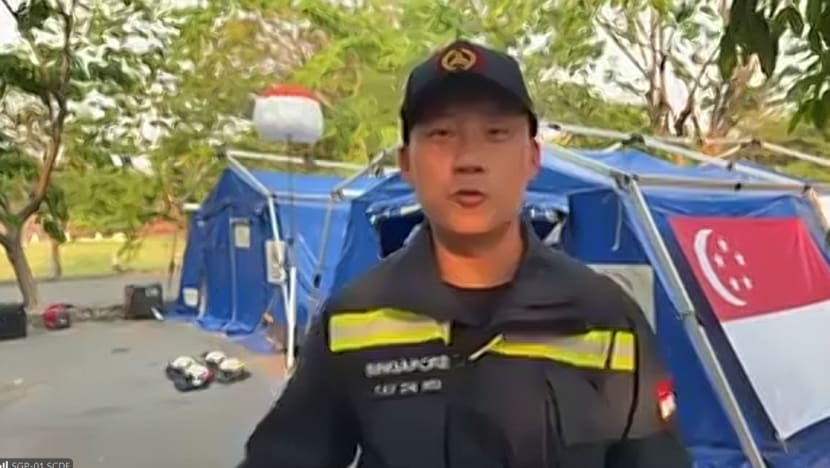ŌĆśAs long as thereŌĆÖs a minute chance of survivalŌĆÖ: SCDF team in Myanmar presses on with quake rescue
The 72-hour ŌĆ£golden windowŌĆØ for finding survivors in quake-hit Myanmar may have passed, but┬ĀSingapore's Operation Lionheart contingent is pushing on with rescue efforts.

Rescuers using a fibre-optic scope under a collapsed residential building. (Photo: SCDF)

This audio is generated by an AI tool.
SINGAPORE:┬ĀThe ŌĆ£golden windowŌĆØ for finding survivors in quake-hit Myanmar may have closed, but SingaporeŌĆÖs Operation Lionheart contingent will carry on as long as there is even a ŌĆ£minute chance of survivalŌĆØ.
This was stressed by Colonel Tay Zhi Wei, the team leader of the contingent, who on Tuesday (Apr 1) spoke to the media about the conditions they were operating under.
The Singapore Civil Defence Force (SCDF) deployed the┬Ā80-member team to Myanmar to assist in disaster rescue efforts a day after the 7.7-magnitude earthquake hit the country on Friday.
The death toll from the earthquake has so far exceeded 2,700 and is expected to top 3,000, Myanmar's military leader Min Aung Hlaing said in a televised address on Tuesday. He added that more than 4,500 people were injured, and over 440 were missing.
ŌĆ£As rescuers, the first 72 hours are extremely crucial,ŌĆØ said the 41-year-old Col Tay, speaking via a video call from Naypyidaw. This ŌĆ£golden windowŌĆØ is the period during which there is the highest chance of finding survivors after a disaster.
ŌĆ£But even after that, there will be chances of survival, and as long as thereŌĆÖs a slim chance of survival, a minute chance of survival, we will be here to lend our hand if they need us.ŌĆØ┬Ā
The fire and rescue officer with SCDF added that just this morning, the local fire service rescued a 60-year-old lady trapped under rubble.

CHALLENGES
As they race against time, rescuers in Myanmar are also operating under tough conditions.
One of the challenges the team faced was the hot weather. ŌĆ£It is 41 degrees (Celsius), so we had to institute a certain work-rest cycle in order to keep ourselves going for the prolonged ops and we also need to hydrate ourselves very frequently,ŌĆØ said Col Tay.
The contingent was also one of the first teams on the ground and was requested to start work immediately, so it had little time to set up and establish communication with its base camp, he said.
However, the morale of the officers are ŌĆ£extremely highŌĆØ, said Col Tay. The welfare of the personnel was also taken care of as it was eventually able to set up its base camp near a hotel, enabling the team to use facilities such as the function room and car park.
ŌĆ£In general, the mood is very focused on our mission at hand.ŌĆØ
In response to a ┬ķČ╣ query on how this operation differs from past ones, Col Tay noted that the team was escorted by the local fire service wherever it went.
"That works for us because ... they would have a good appreciation of the situation on the ground and they will bring us to focused areas where they think there are lives to be saved."
For the contingent's 48 Muslim officers, there were also efforts to keep morale high over Hari Raya Puasa - which fell on Monday.
"It was an extremely busy┬Āday and (rescue operations) took us all the way until nightfall before we returned back to base," said Col Tay.
The team, however, was able to conclude their day with a few Hari Raya messages for Muslim teammates, which gave them a "boost", he added.┬Ā
SAVING A LIFE
Sharing their experience on rescuing a man from under a collapsed building on Sunday after an eight-hour operation, Col Tay said it happened at just the second site the team went to.
Before that, what they saw had worried them.
ŌĆ£The first site that we visited, there were residential buildings and what we observed was that the second floor came down to the first, and the first floor completely gave way,ŌĆØ he said.
ŌĆ£We were thinking, if all the buildings were like this, it would be a significant challenge for us to conduct any search and rescue ops.ŌĆØ
When they arrived at the second site, to their surprise, the man was able to respond despite him being in a ŌĆ£precarious positionŌĆØ.┬Ā
ŌĆ£We needed to skirt on the side of the building, and then in between two buildings, there was a small void, and we had to enter through the small void in order to reach a concrete slab,ŌĆØ he said as he detailed the operation.
Through a small hole in the concrete slab, they could hear the manŌĆÖs voice. However, expanding that hole would affect the integrity of the rubble in the area, he explained.
So the team used their tools to create a second hole. After eight hours, they were able to reach the man and bring him out. He sustained only minor injuries, mostly bruises on his leg.
The local fire service then took over the medical treatment and sent him to a hospital.
ŌĆ£I think that really gave us a boost, because after the first site, we were thinking it would be a very, very difficult search-and-rescue operation.
ŌĆ£(This incident) gave us hope that there are more lives that we can save.ŌĆØ
Thus far, the contingent had completed 13 sites in total and rescued one person, while also locating numerous bodies.┬Ā
When asked when the team would transit from search-and-rescue operations to begin focusing on recovering bodies, Col Tay said that the call would have to be made by MyanmarŌĆÖs National Disaster Management Office.
At this point, he reiterated the team's determination to save lives.
ŌĆ£I think we can still go on for several days, and as long as there is a minute chance, we will carry on.ŌĆØ












